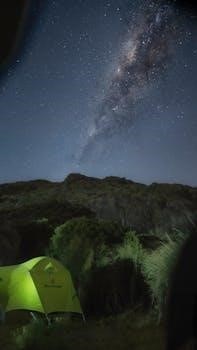
life in the universe 5th edition pdf
Life in the Universe 5th Edition PDF⁚ A Comprehensive Guide
Embark on an extraordinary journey through space and science with the 5th Edition! Explore the cosmos and address age-old questions regarding our place in it. This edition is ideal for anyone curious about the universe and the potential for life beyond Earth, updated and ready for exploration.
Overview of “Life in the Universe” 5th Edition
“Life in the Universe” 5th Edition serves as a leading textbook in astrobiology, crafted for introductory one-semester courses. This comprehensive guide delves into the captivating realm of life’s possibility beyond Earth, inspiring students to explore fundamental questions about our existence and the cosmos. Authored by renowned science communicators, educators, and researchers, this edition is thoroughly revised and updated, reflecting the latest advancements in the field.
The textbook embraces a student-centered approach, promoting active learning and the development of metacognitive skills. Its high-structure design optimizes learning outcomes, making complex concepts accessible and engaging. This edition explores the origins of life on Earth, the search for habitable environments in the universe, and the potential for colonizing other celestial bodies.
With a focus on clarity and scientific accuracy, “Life in the Universe” 5th Edition is an indispensable resource for anyone seeking to understand astrobiology and the profound questions it addresses. It inspires curiosity and empowers students to think critically about our place in the vast expanse of the cosmos.
Key Questions Addressed in the Textbook
“Life in the Universe” 5th Edition tackles some of the most profound and captivating questions that have intrigued humanity for centuries. It begins by probing the very origins of life on Earth, exploring the conditions and processes that allowed life to emerge from non-living matter. The book examines what defines life, and if that definition can be used to identify life beyond our planet.
The textbook then expands its scope to the cosmos, investigating the possibility of other habitable worlds. It questions whether Earth is unique or if other planets or moons could harbor life. It explores the factors that make a planet habitable, such as the presence of liquid water, a suitable atmosphere, and a source of energy.
Furthermore, the book delves into the search for extraterrestrial life, examining the methods scientists use to detect signs of life beyond Earth. It explores the possibility of colonizing other planets, moons, or even star systems. These questions are central to astrobiology and drive the exploration of our universe.
Astrobiology⁚ The Core Focus
Astrobiology serves as the central theme that binds “Life in the Universe.” The book emphasizes the interdisciplinary nature of astrobiology, drawing upon principles from biology, chemistry, physics, astronomy, and geology to explore the potential for life beyond Earth. It presents astrobiology as a rigorous scientific field that seeks to understand the origin, evolution, distribution, and future of life in the universe.
The textbook highlights the importance of understanding life on Earth as a foundation for searching for life elsewhere. By studying the diversity of life on our planet, including extremophiles that thrive in harsh environments, scientists can better define the limits of life and identify potential habitats on other worlds.

Moreover, the book examines the ethical and philosophical implications of discovering extraterrestrial life. It addresses the potential impact on society, religion, and our understanding of our place in the cosmos. Astrobiology, as presented in this edition, is not just a scientific pursuit but also a human endeavor that challenges our perspectives and expands our horizons.

Authors and Their Expertise
“Life in the Universe, 5th Edition” benefits immensely from the collective expertise of its authors⁚ Jeffrey Bennett, Seth Shostak, Nicholas Schneider, and Meredith MacGregor. This team brings together a diverse range of knowledge and experience in astronomy, astrobiology, science communication, and education.
Jeffrey Bennett is a well-known author and educator with a passion for making science accessible to the public. Seth Shostak, a senior astronomer at the SETI Institute, brings decades of experience in the search for extraterrestrial intelligence. Nicholas Schneider contributes his expertise in planetary science and atmospheric studies. Meredith MacGregor adds her knowledge of stellar astrophysics and the formation of planetary systems.
Their combined expertise ensures that the textbook provides a comprehensive and up-to-date overview of astrobiology. The authors’ backgrounds in research, education, and science communication make the book both scientifically rigorous and engaging for students. They are renowned science communicators and researchers that convey the story of modern science.
Ideal Course for This Textbook
“Life in the Universe, 5th Edition” is ideally suited for a one-semester introductory course in astrobiology or related fields. Its comprehensive coverage and student-centered approach make it perfect for undergraduate students with varying levels of scientific background. The textbook’s engaging writing style and clear explanations of complex concepts ensure that students remain interested and motivated throughout the course.
The book’s structure promotes active learning and self-regulated study, encouraging students to take ownership of their learning process. Instructors can use the textbook to design high-structure courses that optimize learning outcomes and help students develop metacognitive skills. The textbook’s content aligns with the core topics in astrobiology, including the origin of life, the search for extraterrestrial life, and the habitability of planets.
Furthermore, the book fosters curiosity by exploring fundamental questions and sparking interest in students to explore the possibility of life beyond Earth. Teachers and students of wildly popular courses can rejoice at the update of this classic textbook.
Exploring the Possibility of Extraterrestrial Life

The 5th edition delves deep into the captivating question of whether we are alone in the cosmos. It meticulously examines the scientific methods employed in the search for extraterrestrial life, including the detection of biosignatures in exoplanetary atmospheres and the exploration of potentially habitable environments within our solar system and beyond. The text explores the conditions necessary for life to arise and thrive, considering various possibilities beyond the familiar parameters of Earth-based life.
Furthermore, the book addresses the potential for colonizing other planets and star systems. Ethical considerations and challenges associated with such endeavors are critically examined. It encourages students to think critically about the implications of discovering extraterrestrial life, its potential impact on society, and the responsibilities that come with it. The book explores the latest discoveries and ongoing missions dedicated to the search, offering a comprehensive overview of this exciting and rapidly evolving field.
Could we colonize other planets, moons, or even other star systems? Are we alone in the cosmos? How are scientists seeking signs of life beyond our home planet?
Revisions and Updates in the 5th Edition
The 5th edition of “Life in the Universe” showcases significant revisions and updates, reflecting the rapid advancements in astrobiology and related fields. This edition incorporates the latest discoveries from ongoing missions, such as the James Webb Space Telescope, providing students with the most current understanding of planetary science and exoplanet research. Furthermore, the text has been updated to include new perspectives on the origins of life, the potential for life in extreme environments, and the search for extraterrestrial intelligence (SETI);
The revisions also address recent developments in our understanding of habitability, including the role of geological activity and the potential for subsurface oceans on other celestial bodies. In addition, the 5th edition includes updated discussions on the ethical considerations surrounding space exploration, planetary protection, and the potential impact of discovering extraterrestrial life. New case studies and examples have been integrated throughout the text to enhance student engagement and understanding.
Teachers and students everywhere of wildly popular courses on life in the universe should rejoice to see this update of the classic textbook.
Student-Centered Approach and Learning Outcomes
The 5th edition of “Life in the Universe” employs a student-centered approach, prioritizing active learning and the development of critical thinking skills. The textbook promotes high-structure course design, encouraging students to engage with the material through interactive exercises, thought-provoking questions, and real-world case studies. This approach aims to foster a deeper understanding of astrobiology concepts and their implications.
Designed for a one-semester introductory course, the textbook enables students to develop metacognitive skills. The learning outcomes are carefully aligned with the course content, ensuring that students acquire a comprehensive understanding of the key principles of astrobiology. By the end of the course, students should be able to articulate the goals of astrobiology, evaluate the evidence for extraterrestrial life, and assess the challenges and opportunities associated with space exploration.
The textbook also incorporates a range of pedagogical features, such as concept checks, chapter summaries, and end-of-chapter questions, to support student learning and facilitate self-assessment. By fostering a student-centered learning environment, the 5th edition empowers students to become active participants in their own education and develop a lifelong interest in the wonders of the universe.
Availability and Where to Buy
“Life in the Universe,” 5th Edition, is widely accessible through various channels, catering to diverse student and educator needs. For those seeking a physical copy, the textbook is readily available at major online retailers such as Amazon, Target, and Barnes & Noble. These platforms often offer competitive pricing and convenient shipping options, ensuring that students can easily acquire the book.

In addition to online retailers, many college and university bookstores stock the textbook, providing students with a familiar and reliable source. Checking with the campus bookstore is a great way to ensure you’re getting the correct edition and any required supplementary materials. Furthermore, digital versions of the textbook are often available for purchase or rental through platforms like RedShelf and other e-book providers.
These digital options offer the convenience of accessing the textbook on various devices, along with features like searchability and highlighting. Always compare prices and consider rental options to find the most cost-effective solution. Be sure to verify the ISBN or edition number to guarantee you are purchasing the correct version for your course.
Supplementary Resources and Online Homework Platforms
To enhance the learning experience, “Life in the Universe,” 5th Edition, is often accompanied by a wealth of supplementary resources designed to aid both students and instructors. These resources may include a solutions manual, providing detailed answers to end-of-chapter questions, and a test bank, offering a variety of assessment tools for instructors to gauge student understanding.
Furthermore, many publishers offer online homework platforms, such as Expert TA, which provide interactive exercises, tutorials, and personalized feedback to help students master the material. These platforms often integrate directly with the textbook, offering a seamless learning experience. Instructors can use these platforms to track student progress and identify areas where additional support may be needed.
In addition to publisher-provided resources, there are numerous online resources available, including websites, videos, and simulations, that can supplement the textbook. Students should also explore online forums and study groups to connect with peers and share insights. By utilizing these supplementary resources and online homework platforms, students can deepen their understanding of astrobiology and improve their overall performance in the course. Always check with your instructor for recommended resources specific to your course.


Leave a Reply
You must be logged in to post a comment.